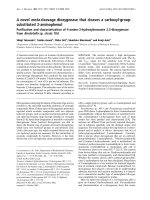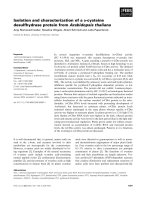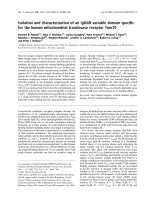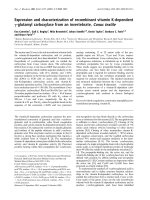Isolation and characterization of highly pathogenic avian influenza virus subtype H5N1 from donkeys docx
Bạn đang xem bản rút gọn của tài liệu. Xem và tải ngay bản đầy đủ của tài liệu tại đây (2.8 MB, 6 trang )
Abdel-Moneim et al. Journal of Biomedical Science 2010, 17:25
/>Open Access
RESEARCH
BioMed Central
© 2010 Abdel-Moneim et al; licensee BioMed Central Ltd. This is an Open Access article distributed under the terms of the Creative Com-
mons Attribution License ( which permits unrestricted use, distribution, and reproduc-
tion in any medium, provided the original work is properly cited.
Research
Isolation and characterization of highly pathogenic
avian influenza virus subtype H5N1 from donkeys
Ahmed S Abdel-Moneim*
1,2
, Ahmad E Abdel-Ghany
3
and Salama AS Shany
4
Abstract
Background: The highly pathogenic H5N1 is a major avian pathogen that crosses species barriers and seriously affects
humans as well as some mammals. It mutates in an intensified manner and is considered a potential candidate for the
possible next pandemic with all the catastrophic consequences.
Methods: Nasal swabs were collected from donkeys suffered from respiratory distress. The virus was isolated from the
pooled nasal swabs in specific pathogen free embryonated chicken eggs (SPF-ECE). Reverse transcriptase polymerase
chain reaction (RT-PCR) and sequencing of both haemagglutingin and neuraminidase were performed. H5
seroconversion was screened using haemagglutination inhibition (HI) assay on 105 donkey serum samples.
Results: We demonstrated that H5N1 jumped from poultry to another mammalian host; donkeys. Phylogenetic
analysis showed that the virus clustered within the lineage of H5N1 from Egypt, closely related to 2009 isolates. It
harboured few genetic changes compared to the closely related viruses from avian and humans. The neuraminidase
lacks oseltamivir resistant mutations. Interestingly, HI screening for antibodies to H5 haemagglutinins in donkeys
revealed high exposure rate.
Conclusions: These findings extend the host range of the H5N1 influenza virus, possess implications for influenza virus
epidemiology and highlight the need for the systematic surveillance of H5N1 in animals in the vicinity of backyard
poultry units especially in endemic areas.
Background
Influenza A viruses belong to the family Orthomyxoviri-
dae and have been isolated from a variety of different spe-
cies. Further subtyping of influenza A viruses is based on
antigenic differences between the two surface glycopro-
teins haemagglutinin (H1-H16) and neuraminidase (N1-
N9) of the influenza A viruses [1,2]. The HA mediates the
attachment of the virus to sialic-acid-containing recep-
tors on the host cell surface, as well as the fusion of the
virus envelope with the cellular membrane [3,4]. The
specificity of the HA towards these molecules differs.
Avian and equine influenza viruses preferentially bind the
sialic acid α-2,3-galactose (SAα2,3Gal) linkage, while
human influenza viruses preferentially bind the
SAα2,6Gal linkage [5-7]. The highly pathogenic avian
influenza virus H5N1 (HPAIV- H5N1) represents an
important poultry pathogen and a major havoc to the
poultry industry. Furthermore, HPAIV H5N1 infections
in poultry constitute a threat to mammals including
humans. Apart from humans, the natural infections of
H5N1 influenza A have been reported in several mam-
malian species including domestic cats [8], tigers and
leopards [9], dogs [10], pigs [11] and stone marten [12].
Experimentally, H5N1 has also been able to infect mice
[13], ferrets [14], monkeys [15] and cattle [16]. Infections
in either experimental or naturally infected hosts have
been fatal except for pigs and cattle where mild to sub-
clinical infections have been detected [11,16]. No natu-
rally occurring cases of H5N1 HPAI have been reported
in horses or other members of the Perissodactyla order
nor have any experimental studies been published [17].
An equine influenza virus;H3N8 with avian gene pool has
been isolated emphasizing that equines may be suscepti-
ble to avian influenza viruses of the H3N8 subtype[18]
and possibly others. The family Equidae and in particular
donkeys may be of great importance in certain endemic
* Correspondence:
1
Department of Virology, Faculty of Veterinary Medicine, Beni-Suef University,
Beni-Suef 62511, Egypt
Full list of author information is available at the end of the article
Abdel-Moneim et al. Journal of Biomedical Science 2010, 17:25
/>Page 2 of 6
countries like Egypt where they are commonly housed
together with poultry. Long term endemic influenza virus
infections in poultry increase exposure risks to surround-
ing humans and other mammals and in turn, create
opportunities for the emergence of human-adapted
strains with pandemic potential [19,20]. Since 2006,
H5N1 influenza A virus has been endemic in Egypt pro-
ducing great economic losses and most importantly hit-
ting humans hard with high case fatality rate; 34/109
(WHO; />country/cases_table_2010_04_09/en/index.html).
Here we report the isolation of HPAI H5N1 from don-
keys living in contact with diseased birds and demon-
strate the presence of H5 seropositive ones in the
neighbouring areas.
Methods
Virus isolation
Nasal swabs were collected from three infected animals
from Aborady village, El-Wasta locality, Beni-Suef Gover-
norate. Each swab was placed in a tube containing 0.5 ml
sterile normal saline containing gentamicin sulfate solu-
tion (50 mg/ml). The swab tip was cut off in the saline
and the tubes were immediately transported to the lab for
testing in an ice box to be processed using a routine
method. Infected materials were pooled, centrifuged at
500 x g for 10 min. and then inoculated into the allantoic
cavity of five, 10-day-SPF-ECE (100 μl/egg). Inoculated
embryos were incubated at 37°C for 24-48 h.
Haemagglutination inhibition
One hundred and five serum samples were collected from
apparently healthy donkeys from different localities in the
Beni-Suef Governorate, 4-6 months after the procedure
of virus isolation. Sera were heat inactivated for 30 min at
56°C and 2-fold serial dilutions were performed in 25-μL
volume in 96-well HI plates. Equal volumes of 4HA of H5
influenza virus antigen (A/chicken/Egypt/F6/
2007(H5N1)) were added to diluted serum samples then
1% suspension of human erythrocytes were dispensed to
Figure 1 Phylogenetic analyses of HA and NA of an equine H5N1 isolate sequence in comparison to Egyptian human and avian isolates. a,
HA gene b, NA gene. Human isolates are shown in blue while avian ones are shown in black whereas equine isolate is shown in red. All sequences
were obtained from GenBank. Trees were generated using Neighbour-Joining method. The robustness of individual nodes of the tree was assessed
using a bootstrap of 1000 resamplings in per cent (70% and higher) are indicated at key nodes.
Abdel-Moneim et al. Journal of Biomedical Science 2010, 17:25
/>Page 3 of 6
each well [21]. HI titers ≥ 3 log
2
were considered positive.
Samples assayed in duplicates and each assay was vali-
dated by comparison with positive and negative chicken
and equine control sera as well as back titration of the
used virus dilutions.
Viral RNA extraction and RT PCR
Viral RNA was extracted from virus containing chorioal-
lantoic membranes (CAM) homogenate by using a SV
Total RNA Isol ation System (Promega Corporation,
Madison, Wis.). The sample was processed alone in a
sterile clean room to avoid the possibility of any cross
contamination. One-step RT-PCR amplification for full
length of both NA and HA genes were performed using
Verso™ 1 step RT PCR (Thermo Fisher Scientific Inc.). A
single set of primers was used for NA (For:ATGAATC-
CAAATCAGAAG, Rev:TGTCAATGGTGAATG-
GCAAC) but for HA, four sets of primers flanking
overlapping regions of the full length gene were used
(Primer sequences for HA were ordered according to that
provided by; Laboratory for Molecular and Biological
Characterization of AIV, FLI, Germany).
Sequence analysis
Amplicons were first subjected to 1% gel electrophoresis
and specific bands were excised and purified using
EzWayTM gel extraction kit (Komabiotech, Korea). Each
purified amplicon was sequenced in both forward and
reverse directions (Macrogen Inc., Korea).
Phylogenetic Analysis
BLAST analyses were initially performed to establish HA
and NA sequence identities to GenBank accessions [22].
Comparative analyses were performed using the
CLUSTAL W Multiple Sequence Alignment Program,
Mega 3.1. AIV representative sequences used for the
alignments were obtained from the GenBank and EMBL
database. The phylogenetic trees were constructed by
using the neighbour-joining method with Kimura two-
parameter distances by using MEGA version 3.1 [23]. The
reliability of internal branches was assessed by 1000 boot-
strap replications and p-distance substitution model.
Results and discussion
In this study, we isolated H5N1 form donkeys clinically
affected with moderate respiratory distress including
Figure 2 Deduced amino acid sequences of the HA protein of equine H5N1 isolate in comparison to closely related Egyptian HPAIV H5N1
isolates. Dots denote identical amino acids, which are given in one-letter code. Consensus sequences for N-glycosylation (NXS or NXT, except where
X = P) are underlined. Boxed segments indicate the signal peptide and the polybasic proteolytic cleavage motif, respectively. Shaded letters denote
potential sites responsible for receptor binding sites (H3 influenza numbering).
Abdel-Moneim et al. Journal of Biomedical Science 2010, 17:25
/>Page 4 of 6
cough, fever and serous nasal discharge. The course of the
disease was short (72 h) and responsive well after two
shots of streptomycin/penicillin antibiotic therapy and
one shot of antipyretic (Diclofenac sodium) with no
recorded mortalities. The inhibition induced by antibi-
otic to the possible secondary bacterial invasion, besides
the moderate severity of the H5N1 in donkeys may be
responsible for the recovery of the infected animals with-
out further complications. The disease recoded on 24
th
March 2009, 1 wk after an outbreak of H5N1 infection in
poultry in the village, where many donkeys suffered from
the same clinical manifestations in an epidemic manner.
The virus was isolated from a pool of nasal discharge
from three affected animals. It produced haemagglutina-
tion only after the 3
rd
egg passage. RT-PCR was per-
formed to the full length of both NA and HA genes,
where they were sequenced directly after gel purification.
Sequences were deposited in GenBank under accession
numbers; GU371911
and GU371912 for HA and NA
respectively. The HA and NA genes of the investigated
equine isolates revealed that they belonged to (5J), (1J)
lineages respectively (According to the Influenza A Virus
Genotype Tool) [24]. Phylogenetic analyses revealed that
the HA of the equine isolate related to sublineages, A
(A1) (Fig. 1). The equine isolate showed a typical polyba-
sic cleavage motif with the GERRRKKR*GLF consensus
sequence found in clade 2.2 viruses. It also contains
amino acid D403 characteristic to sub-clade 2.2.1 (Fig. 2).
The haemagglutinin gene was found to be closely related
to A/chicken/Egypt/0894-NLQP/2008, A/Egypt/N00605/
2009 and A/chicken/Egypt/092-NLQP/2009 while the
neuraminidase gene of the current strain is closely related
to A/Egypt/N03450/2009 and A/Egypt/N05056/2009.
However, none of these strains were isolated from locali-
ties near to Beni-Suef.
The equine isolate has amino acids Q226 and G228 (H3
influenza numbering) denoting the preferential binding
Figure 4 Beni-Suef map, showed the distribution of H5 seroposi-
tive equine samples (donkeys). HI test was performed using local
Egyptian antigen (A/chicken/Egypt/F6/2007), red box denotes the lo-
cality where the A/Egypt/equine/av1/2009 was isolated.
Figure 3 Deduced amino acid sequences of NA protein of equine H5N1 isolate in comparison to two recent closely related and other dis-
tant isolates that showed resistant to oseltamivir. Dots indicate residues identical amino acids. Underlined letters are N-glycosylation sites, shaded
letters showed site of H274Y and N294S substitutions (H275Y and N295S in N1 influenza numbering).
Abdel-Moneim et al. Journal of Biomedical Science 2010, 17:25
/>Page 5 of 6
of α-2,3 linkage, typical for the avian and equine viruses
but not human ones [5,25]. This finding demonstrated
that the isolates with avian specific receptor binding
properties can replicate and cause infection in equines.
Different amino-acids that are implicated in receptor
specificity Y98, S136, W153, H183, E190, K193 L194
E216 P221 K222 G225, Q226, S227, G228 (H3 influenza
numbering) were tested [26]. Interestingly 98 (Y to N),
193 (K to R), 216 (E to K) and 221(P to S) which were
found in the examined equine isolate have also been in
many other isolates from the middle east in the flu data-
base which raises a question as to what the impact of such
substitution on HA binding to human receptors is.
Recently, A138V, N186K and S227N mutations were
reported to confer α-2,6-linked sialic acid binding to
H5N1 virus [27-30]. None of such substitutions were
found in the equine isolate. The HA of the human or
avian Egyptian isolates, contains a total of seven potential
N-glycosylation signals whereas the equine isolate con-
tains an additional N-glycosylation (Fig. 2).
In addition, the equine isolate lacks aa S145. This dele-
tion is also present in all other viruses grouped into 2.2
sublineage A1, which also includes sequences from
human H5N1 isolates (Fig. 2). The significance of this
deletion is unknown, but it should be noted that this posi-
tion is close to a domain modulating receptor interaction.
Interestingly, strains with this deletion appear to evolve
towards a receptor usage that is similar to that of the sea-
sonal human H1N1[31].
Analysis of the NA gene revealed the presence of the
20-amino acid deletion (Fig. 3) as well as the presence of
amino-acid R at position 110 which is characteristic of
clade 2.2 viruses [32]. Three potential N-glycosylation
sites were predicted (Fig. 3). The 228 (N to S) substitution
is also present and indicative to 2.2.1 virus (2009). Four
NA mutations; E119G, H274Y, R292K, and N294S have
been reported to confer resistance to NA inhibitors [33]
but none were detected in the equine isolate.
Speculating that infected animals may mount an anti-
body response depending on the interval post infection,
we screened H5-specific antibodies 4-6 months after the
initial virus isolation. The H5 specific antibodies were
detected in naturally affected animals. 27 out of 105
(25.71%) of the examined animals were H5 positive with
the highest percentage found in the area where the virus
was isolated (Table 1, Fig. 4).
Conclusion
We did note the incidence of clinical infections of don-
keys with HPAIV (H5N1) in disease endemic regions
where the probability of intimate contact between poul-
try and donkeys is high. Furthermore, H5 seroconversion
by naturally exposed donkeys was evidenced. Although
the disease did not constitute a real threat to donkeys, it
raises the concern of different issues including the route
of transmission to donkeys, whether being from aerosol
exposure of pulverized infected birds droppings or con-
taminated feeds and water or because of contact with
infected birds. Second, the role of donkeys in spreading
H5N1 virus to birds, humans and other mammals includ-
ing equines needs to be assessed.
Competing interests
The authors declare that they have no competing interests.
Authors' contributions
ASA and AEA designed, performed experiments, and analyzed data. ASA gen-
erated genetic constructs and drafts the manuscript. AEA and SASS performed
the HI analyses and helped in RT-PCR. AEA reviewed the manuscript.
Author Details
1
Department of Virology, Faculty of Veterinary Medicine, Beni-Suef University,
Beni-Suef 62511, Egypt,
2
Division of Virology, Department of Microbiology,
College of Medicine and Medical Sciences, Taif University, Al-Taif, Saudi Arabia,
3
Department of Hygiene, Management & Zoonoses, Faculty of Veterinary
Medicine, Beni-Suef University, Beni-Suef 62511, Egypt and
4
Department of
Poultry Diseases, Faculty of Veterinary Medicine, Beni-Suef University, Beni-Suef
62511, Egypt
Received: 2 February 2010 Accepted: 14 April 2010
Published: 14 April 2010
This article is available from: 2010 Abdel-Moneim et al; licensee BioMed Central Ltd. This is an Open Access article distributed under the terms of the Creative Commons Attribution License ( which permits unrestricted use, distribution, and reproduction in any medium, provided the original work is properly cited.Journa l of Biome dical Scie nce 2010, 17:25
Table 1: Serological screening of H5N1 exposure in donkeys from different localities of Beni-Suef Governorate using
haemagglutination inhibition assay
Locality Samples HI range
(Log2)
Number Positive Negative Positive %
Beni-Suef161156.257
El-Fashn 33 10 23 30.30 8-10
Ehnasia 8 0 8 00.00 0-2
El-Wasta 15 8 7 53.33 6-9
Naser 33 8 25 24.24 7-8
Total 105 27 78 25.71
Abdel-Moneim et al. Journal of Biomedical Science 2010, 17:25
/>Page 6 of 6
References
1. Murphy BR, Webster RG: Orthomyxoviruses. In Fields Virology
Philadelphia: Lippincott-Raven; 1996.
2. Fouchier RAM, Munster V, Wallensten A, Bestebroer TM, Herfst S, Smith D,
Rimmelzwaan GF, Olsen B, Osterhaus AD: Characterization of a novel
influenza A virus hemagglutinin subtype (H16) obtained from black-
headed gulls. J Virol 2005, 79(5):2814-22.
3. Rott R, Klenk HD, Nagai Y, Tashiro M: Influenza viruses, cell enzymes, and
pathogenicity. Am J Respir Crit Care Med 1995, 152:S16-S19.
4. Katz JM, Lu X, Tumpey TM, Smith CB, Shaw MW, Subbarao K: Molecular
correlates of influenza A H5N1 virus pathogenesis in mice. J Virol 2000,
74:10807-10810.
5. Connor RJ, Kawaoka Y, Webster RG, Paulson JC: Receptor specificity in
human, avian, and equine H2 and H3 influenza virus isolates. Virology
1994, 205:17-23.
6. Rogers GN, Paulson JC: Receptor determinants of human and animal
influenza virus isolates: differences in receptor specificity of the H3
hemagglutinin based on species of origin. Virology 1983, 127:361-373.
7. Rogers GN, D'Souza BL: Receptor binding properties of human and
animal H1 influenza virus isolates. Virology 1989, 173:317-322.
8. Kuiken T, Rimmelzwaan G, van Riel D, van Amerongen G, Baars M,
Fouchier R, Osterhaus A: Avian H5N1 influenza in cats. Science 2004,
306:241.
9. Keawcharoen J, Oraveerakul K, Kuiken T, Fouchier RA, Amonsin A,
Payungporn S, Noppornpanth S, Wattanodorn S, Theambooniers A,
Tantilertcharoen R, Pattanarangsan R, Arya N, Ratanakorn P, Osterhaus
DM, Poovorawan Y: Avian influenza H5N1 in tigers and leopards. Emerg
Infect Dis 2004, 10:2189-2191.
10. Songserm T, Amonsin A, Jam-on R, Sae-Heng N, Pariyothorn N,
Payungporn S, Theamboonlers A, Chutinimitkul S, Thanawongnuwech R,
Poovorawan Y: Fatal avian influenza A H5N1 in a dog. Emerg Infect Dis
2006, 12:1744-1747.
11. Li HY, Yu K, Yang H, Xin X, Chen J, Zhao P, Bi Y: Isolation and
characterization of H5N1 and H9N2 influenza viruses from pigs in
China. Chin J Prev Vet Med 2004, 26:1-6.
12. Klopfleisch R, Wolf PU, Wolf C, Harder T, Starick E, Niebuhr M, Mettenleiter
TC, Teifke JP: Encephalitis in a stone marten (Martes foina) after natural
infection with highly pathogenic avian influenza virus subtype H5N1.
J Comp Pathol 2007, 137:155-159.
13. Gao P, Watanabe S, Ito T, Goto H, Wells K, McGregor M, Cooley AJ,
Kawaoka Y: Biological heterogeneity, including systemic replication in
mice, of H5N1 influenza A virus isolates from humans in Hong Kong. J
Virol 1999, 73:3184-3189.
14. Zitzow LA, Rowe T, Morken T, Shieh WJ, Zaki S, Katz JMx: Pathogenesis of
avian influenza A (H5N1) viruses in ferrets. J Virol 2002, 76:4420-4429.
15. Kuiken T, Rimmelzwaan GF, Van Amerongen G, Osterhaus AD: Pathology
of human influenza A (H5N1) virus infection in cynomolgus macaques
(Macaca fascicularis). Vet Pathol 2003, 40:304-310.
16. Kalthoff D, Hoffmann B, Harder T, Durban M, Beer M: Experimental
infection of cattle with highly pathogenic avian influenza virus (H5N1).
Emerg Infect Dis 2008, 14:1132-1134.
17. Cardona CJ, Xing Z, Sandrock CE, Davis CE: Avian influenza in birds and
mammals. Comp Immunol Microbio Infec Dis 2009, 32(4):255-273.
18. Guo Y, Wang M, Kawaoka Y, Gorman O, Ito T, Saito T, Webster RG:
Characterization of a new avian-like influenza A virus from horses in
China. Virology 1992, 188:245-255.
19. Matrosovich M, Zhou N, Kawaoka Y, Webster R: The surface
glycoproteins of H5 influenza viruses isolated from humans, chickens,
and wild aquatic birds have distinguishable properties. J Virol 1999,
73:1146-1155.
20. Webster RG, Wright SM, Castrucci MR, Bean WJ, Kawaoka Y: Influenza-a
model of an emerging virus disease. Intervirology. 1993, 35(1-4):16-25.
21. Beard CW: Serological procedures. In American Association of Avian
Pathologists Iowa: Kendall/Hunt Publishing Company; 1989.
22. Altschul SF, Gish W, Miller W, Myers EW, Lipman DJ: Basic local alignment
search tool. J Mol Biol 1990, 15:403-410.
23. Kumar S, Tamura K, Jakobsen IB, Nei M: Molecular evolutionary genetics
analysis software. Bioinformatics 2001, 17(12):1244-1245.
24. Lu G, Rowley T, Garten R, Donis RO: FluGenome: a web tool for
genotyping influenza A virus. Nucleic Acids Res 2007, 35:W275-279.
25. Suzuki Y, Ito T, Suzuki T, Holland RJ, Chambers TM, Kiso M, Ishida H,
Kawaoka Y: Sialic acid species as a determinant of the host range of
influenza a viruses. J Virol 2000, 74:11825-11831.
26. Stevens J, Blixt O, Tumpey TM, Taubenberger JK, Paulson JC, Wilson IA:
Structure and receptor specificity of the hemagglutinin from an H5N1
influenza virus. Science. Science 2006, 312:404-410.
27. Shinya K, Hatta M, Yamada S, Takada A, Watanabe S, Halfmann P, Horimoto
T, Neumann G, Kim JH, Lim W, Guan Y, Peiris M, Kiso M, Suzuki T, Suzuki Y,
Kawaoka Y: Characterization of a human H5N1 influenza A virus
isolated in 2003. J Virol 2005, 79:9926-9932.
28. Gambaryan A, Tuzikov A, Pazynina G, Bovin N, Balish A, Klimov A:
Evolution of the receptor binding phenotype of influenza A (H5)
viruses. Virology 2006, 344:432-438.
29. Yamada S, Suzuki Y, Suzuki T, Le MQ, Nidom CA, Sakai-Tagawa Y,
Muramoto Y, Ito M, Kiso M, Horimoto T, Shinya K, Sawada T, Kiso M, Usui T,
Murata T, Lin Y, Hay A, Haire LF, Stevens DJ, Russell RJ, Gamblin SJ, Skehel
JJ, Kawaoka Y: Haemagglutinin mutations responsible for the binding
of H5N1 influenza A viruses to human-type receptors. Nature 2006,
444:378-382.
30. Auewarakul P, Suptawiwat O, Kongchanagul A, Sangma C, Suzuki Y,
Ungchusak K, Louisirirotchanakul S, Lerdsamran H, Pooruk P,
Thitithanyanont A, Pittayawonganon C, Guo CT, Hiramatsu H,
Jampangern W, Chunsutthiwat S, Puthavathana P: An avian influenza
H5N1 virus that binds to a human-type receptor. J Virol 2007,
81:9950-9955.
31. Veljkovic V, Veljkovic N, Muller CP, Müller S, Glisic S, Perovic V, Köhler H:
Characterization of conserved properties of hemagglutinin of H5N1
and human influenza viruses: possible consequences for therapy and
infection control. BMC Struct Biol 2009, 9:21.
32. Chen H, Smith GJ, Li KS, Wang J, Fan XH, Rayner JM, Vijaykrishna D, Zhang
JX, Zhang LJ, Guo CT, Cheung CL, Xu KM, Duan L, Huang K, Qin K, Leung
YH, Wu WL, Lu HR, Chen Y, Xia NS, Naipospos TS, Yuen KY, Hassan SS, Bahri
S, Nguyen TD, Webster RG, Peiris JS, Guan Y: Establishment of multiple
sublineages of H5N1 influenza virus in Asia: implications for pandemic
control. Proc Natl Acad Sci USA 2006, 103:2845-2850.
33. Yen HL, Ilyushina NA, Salomon R, Hoffmann E, Webster RG, Govorkova EA:
Neuraminidase inhibitor-resistant recombinant A/Vietnam/1203/04
(H5N1) influenza viruses retain their replication efficiency and
pathogenicity in vitro and in vivo. J Virol 2007, 81(22):12418-12426.
doi: 10.1186/1423-0127-17-25
Cite this article as: Abdel-Moneim et al., Isolation and characterization of
highly pathogenic avian influenza virus subtype H5N1 from donkeys Journal
of Biomedical Science 2010, 17:25









